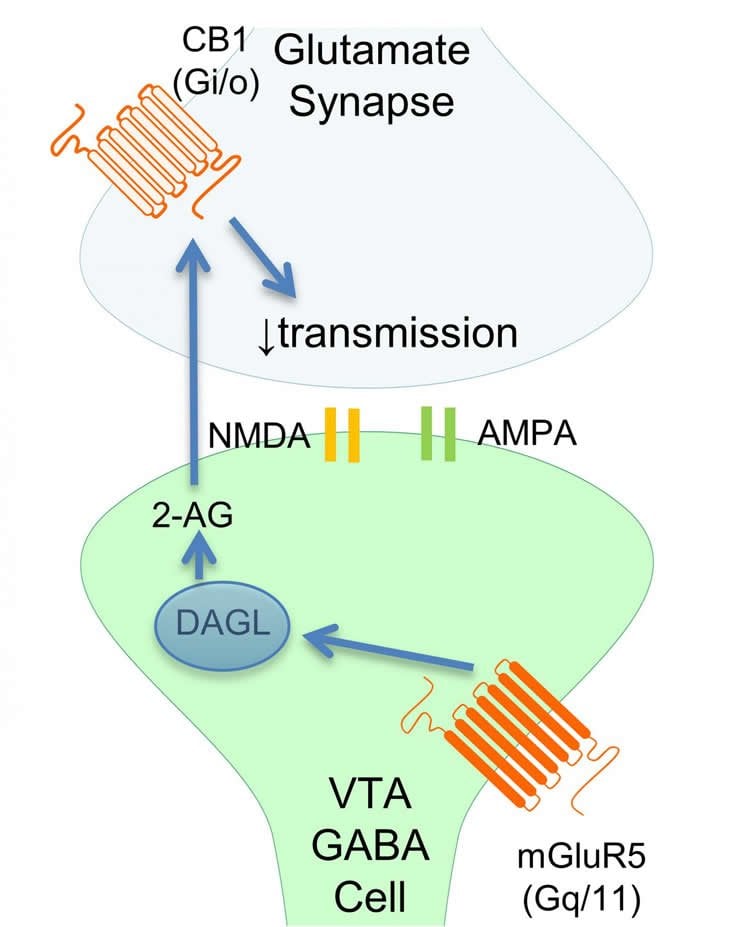Summary: Findings shed light on the effect of marijuana on the developing brain and provide a target for cannabis use disorder.
Source: SfN.
A better understanding of marijuana’s effects on the developing brain is needed as the drug’s rapidly changing legal status increases its recreational and medical use in the United States.
Cellular-level changes to a part of the brain’s reward system induced by chronic exposure to the psychoactive component of marijuana may contribute to the drug’s pleasurable and potentially addictive qualities, suggests a study in young mice published in JNeurosci. The results could advance our understanding of marijuana’s effects on the developing brain as the drug’s rapidly changing legal status increases its recreational and medical use in the United States.
Drugs of abuse impact the ventral tegmental area (VTA) of the brain, which is rich in dopamine neurons. Using juvenile and adolescent mice, Jeffrey Edwards and colleagues investigated the effects of tetrahydrocannabinol (THC), the chemical in marijuana responsible for its effects on cognition and behavior, on VTA GABA cells, an understudied inhibitory cell type in the reward system that regulates dopamine levels.
The authors found that a week of daily THC injections, but not a single injection, blocked the recovery of synapses onto VTA GABA cells in the mice. This finding suggests that persistent THC may alter the inhibitory function of these cells, increasing dopamine levels and the rewarding features of marijuana. These GABA neurons may represent a promising new target for treatment of cannabis use disorder, a common condition on the rise in the United States.

Funding: Funding provided by NIH/National Institute of Neurological Diseases and Stoke, NIH/National Institute on Drug Abuse.
Source: David Barnstone – SfN
Image Source: NeuroscienceNews.com images is credited to Friend et al., JNeurosci (2017).
Original Research: Abstract for “CB1-Dependent Long-Term Depression in Ventral Tegmental Area GABA Neurons: a Novel Target for Marijuana” by Lindsey Friend, Jared Weed, Philip Sandoval, Teresa Nufer, Isaac Ostlund and Jeffrey G. Edwardsa in Journal of Neuroscience. Published online October 16 2017 doi:10.1523/JNEUROSCI.0190-17.2017
[cbtabs][cbtab title=”MLA”]SfN “A New Target For Marijuana.” NeuroscienceNews. NeuroscienceNews, 16 October 2017.
<https://neurosciencenews.com/marijuana-target-7743/>.[/cbtab][cbtab title=”APA”]SfN (2017, October 16). A New Target For Marijuana. NeuroscienceNews. Retrieved October 16, 2017 from https://neurosciencenews.com/marijuana-target-7743/[/cbtab][cbtab title=”Chicago”]SfN “A New Target For Marijuana.” https://neurosciencenews.com/marijuana-target-7743/ (accessed October 16, 2017).[/cbtab][/cbtabs]
Abstract
CB1-Dependent Long-Term Depression in Ventral Tegmental Area GABA Neurons: a Novel Target for Marijuana
The ventral tegmental area (VTA) is necessary for reward behavior with dopamine cells critically involved in reward signaling. Dopamine cells in turn are innervated and regulated by neighboring inhibitory GABA cells. Using whole cell electrophysiology in juvenile-adolescent GAD67-GFP male mice we examined excitatory plasticity in fluorescent VTA GABA cells. A novel CB1-dependent long-term depression (LTD) was induced in GABA cells that was dependent on metabotropic glutamate receptor 5, and cannabinoid receptor 1 (CB1). LTD was absent in CB1 knock-out mice, but preserved in heterozygous littermates. Chronic injections of Δ9-tetrahydrocannabinol occluded LTD compared to vehicle injections, however, a single exposure was insufficient to do so. Because Δ9-tetrahydrocannabinol depresses GABA cell activity, downstream dopamine cells will be disinhibited and thus this could potentially result in increased reward. As synaptic modifications by drug of abuse are often tied to addiction, this data suggest a possible mechanism for the addictive effects of Δ9-tetrahydrocannabinol in juvenile-adolescents, by potentially altering reward behavioral outcomes.
Significance Statement:
The present study identifies a novel form of glutamatergic synaptic plasticity in VTA GABA neurons, a currently understudied cell type that is critical for the brain’s reward circuit, and how THC occludes this plasticity. This study specifically addresses a potential unifying mechanism whereby marijuana could exert rewarding and addictive/withdrawal effects. Marijuana use and legalization is a pressing issue for many states. Although marijuana is the most commonly abused illicit drug, the implications of legalized, widespread or continued usage are speculative. This study in juvenile-adolescent aged mice identifies a novel form of synaptic plasticity in VTA GABA cells, and the synaptic remodeling that can occur after THC use.
“CB1-Dependent Long-Term Depression in Ventral Tegmental Area GABA Neurons: a Novel Target for Marijuana” by Kaitlyn M. Fonzi, Merridee J. Lefner, Paul E.M. Phillips, and Matthew J. Wanat in Journal of Neuroscience. Published online October 16 2017 doi:10.1016/j.celrep.2017.07.076






